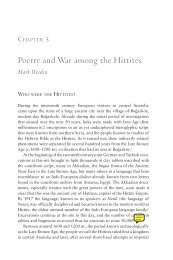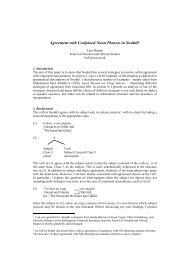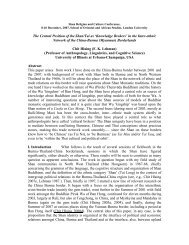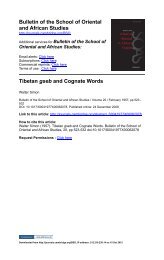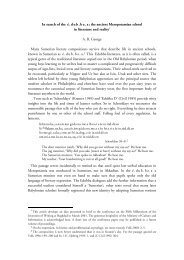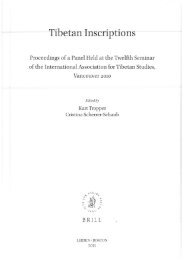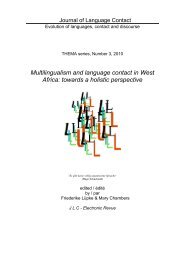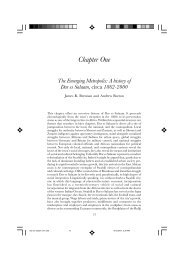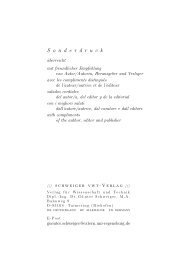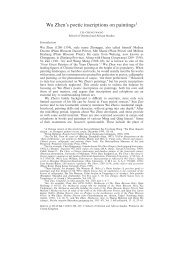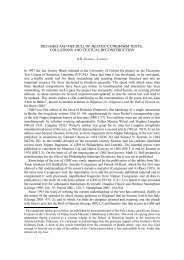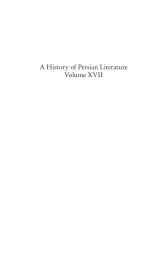Literarische Stoffe - The School of Oriental and African Studies
Literarische Stoffe - The School of Oriental and African Studies
Literarische Stoffe - The School of Oriental and African Studies
Create successful ePaper yourself
Turn your PDF publications into a flip-book with our unique Google optimized e-Paper software.
118<br />
61 De Blois 1996, 49.<br />
Almut Hintze<br />
Unfortunately, this was lost as a result <strong>of</strong> the Achaemenid reform around the time <strong>of</strong> Xerxes<br />
in the early Ÿfth century, when, as shown by François de Blois, a solar calendar <strong>of</strong> exactly 365<br />
days was introduced based on the Egyptian model. 61 Such a year consisted <strong>of</strong> twelve months<br />
<strong>of</strong> 30 days plus Ÿve additional days. This type <strong>of</strong> calendar was similar to that <strong>of</strong> the Avesta in<br />
so far as it also had days that were outside the months, with the difference that the number <strong>of</strong><br />
additional days was Ÿve instead <strong>of</strong> ten. However, since in the Egyptian-style calendar each <strong>of</strong><br />
the twelve months had 30 days, there was no space left for inserting an additional one to<br />
account for the quarter <strong>of</strong> a day by which a solar year exceeds 365. Thus, no provision was<br />
made for intercalation <strong>and</strong> therefore from then on the beginning <strong>of</strong> the year slipped back<br />
relative to the natural year by one day every four years <strong>and</strong> one month every 120, resulting in<br />
the gradual, but inexorable displacement <strong>of</strong> the Zoroastrian feasts with respect to the seasons.<br />
References<br />
Anklesaria, B.T. (1956): Z<strong>and</strong>- k¡s£h. Iranian or Greater Bundahišn. Bombay.<br />
Aufrecht, Th. (1879): Das Aitareya Br¡hma÷a. Bonn.<br />
Bailey, H.W. (1959): “Ambages Indoiranicae.” Annali del Istituto Universitario <strong>Oriental</strong>e di Napoli,<br />
sezione linguistica, 1, 113–146.<br />
Bartholomae, Chr. (1889): “Arisches.” Beiträge zur Kunde der indogermanischen Sprachen,<br />
herausgegeben von Dr. Adalbert Bezzenberger, 15, 1–43.<br />
—— (1904): Altiranisches Wörterbuch. Strassburg.<br />
Bickerman, E.J. 1967: “<strong>The</strong> ‘Zoroastrian’ Calendar.” Archív Orientálni, 35, 197–207.<br />
—— (1983): “Time-Reckoning.” In: E. Yarshater (ed.), <strong>The</strong> Cambridge History <strong>of</strong> Iran, vol. 3(2),<br />
Cambridge: CUP, 778–791.<br />
de Blois, F. (1996): “<strong>The</strong> Persian Calendar.” Iran, 34, 39–54.<br />
—— (2006): “Lunisolar Calendars in Ancient Iran.” In: A. Panaino <strong>and</strong> A. Piras (eds.), Proceedings<br />
<strong>of</strong> the 5 th Conference <strong>of</strong> the Societas Iranologica Europaea held in Ravenna, 6 – 11 October 2003. Vol.<br />
I: Ancient <strong>and</strong> Middle Iranian <strong>Studies</strong>, Milano, 39–52.<br />
Böthlingk, O. & Roth, R. (1855–1875): Sanskrit-Wörterbuch, hrsg. von Kaiserlichen Akademie der<br />
Wissenschaften. 7 vols., St. Petersburg 1855–1875, repr. Delhi, 1990.<br />
Boyce, M. (1970): “On the Calendar <strong>of</strong> Zoroastrian Feasts.” Bulletin <strong>of</strong> the <strong>School</strong> <strong>of</strong> <strong>Oriental</strong> <strong>and</strong><br />
<strong>African</strong> <strong>Studies</strong>, 33, 513–539.<br />
—— (1973): “Translation <strong>and</strong> Notes on D nkard III 259”, apud J. de Menasce, Le troisième livre du<br />
D nkard. Paris, 262–264.<br />
—— (1982): A History <strong>of</strong> Zoroastrianism. Vol. II: Under the Achaemenians. Leiden/Köln (H<strong>and</strong>buch



